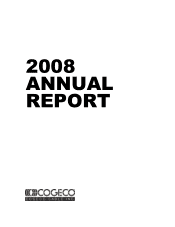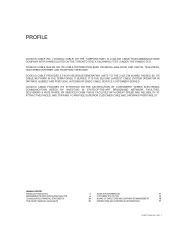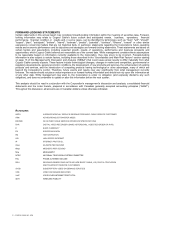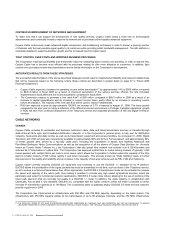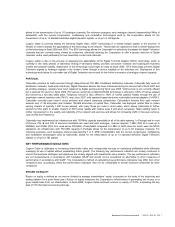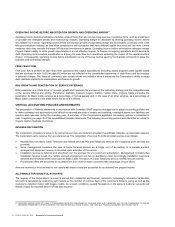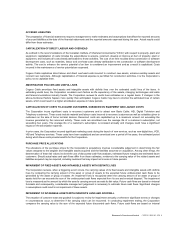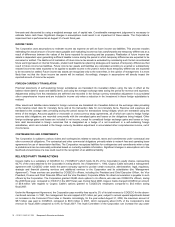Cogeco 2008 Annual Report Download - page 8
Download and view the complete annual report
Please find page 8 of the 2008 Cogeco annual report below. You can navigate through the pages in the report by either clicking on the pages listed below, or by using the keyword search tool below to find specific information within the annual report. Management’s Discussion and Analysis COGECO CABLE INC. 2008 7
allows for the transmission of up to 110 analogue channels. For reference purposes, each analogue channel (representing 6 MHz of
bandwidth), with the current compression, multiplexing and modulation technologies used by the Corporation allows for the
transmission of up to 13 standard definition digital television signals, or of up to 3 HD signals.
Cogeco Cable is currently testing the Switched Digital Video (“SDV”) technology in a limited sample system in the province of
Ontario in order to assess the applicability of this technology to its network. These trials are expected to lead to further deployment
of this technology in fiscal 2009 and 2010. The SDV technology allows the Corporation to selectively broadcast the digital Television
channels that are currently being viewed by customers, effectively allowing the Corporation to offer a greater selection of Digital
channels, and is used particularly for low viewership content and channels.
Cogeco Cable is also in the process of assessing the applicability of the Digital Terminal Adaptor (“DTA”) technology, which is
currently in the early phases of laboratory testing. If laboratory testing provides conclusive evidence and subsequent business
models demonstrate viability, deployment of this technology could begin as early as fiscal 2009. DTA technology converts Digital
Television signals to Analogue signals in the viewer’s home through a device installed on the television set. Deployment of this
technology would allow for a broader use of Digital Television service and for the further conversion of analogue channel capacity.
PORTUGAL
Cabovisão provides its cable services through state-of-the-art 750 MHz broadband distribution networks. Cabovisão fully owns its
distribution networks, head-ends and drops. Digital Television service has been introduced during the second half of fiscal 2007 and
all existing analogue set-tops have been replaced by digital set-tops during fiscal year 2008. VOD service is not currently offered
but is planned for launch in fiscal 2009. HSI service using fully certified DOCSIS technology is offered to 100% of homes passed
and served by a two-way cable plant. Telephony service is also offered to 100% of homes passed, initially through the use of
proprietary network interface units (“NIU”), and, since 2007, with standard based electronic multimedia terminal adapters (“e-MTA”).
Cabovisão currently uses class-5 circuit switches and class-5 advanced softswitches. Cabovisão’s intercity fibre optic network
extends over 2,136 kilometres and includes 196,869 kilometres of optical fibre. Cabovisão has deployed optical fibre to nodes
serving clusters of typically 1,200 homes passed, with many fibres per node in most cases, which allows Cabovisão to further
extend the fibre plant to smaller clusters of 500 homes rapidly with relative ease if and when necessary. Node splitting leads to
further improvement in the quality and reliability of the network and services and allows for increasing traffic of two-way services,
such as HSI and Telephony.
Cabovisão has implemented an infrastructure with 750 MHz capacity essentially in all of its cable systems. In Portugal and in most
of Europe, PAL B and PAL G television standards are used and each analogue channel requires 7 MHz (PAL B is used up to
300MHz) and 8 MHz (PAL G is used above 300 MHz) of bandwidth compared to 6 MHz in North America, which uses the NTSC
standards. An infrastructure with 750 MHz capacity in Portugal allows for the transmission of up to 83 analogue channels. For
reference purposes, each Analogue channel (representing 7 or 8 MHz of bandwidth), with the current compression, multiplexing
and modulation technologies used by Cabovisão, allows for the transmission of up to 13 standard definition Digital Television
signals, or of up to 3 HD signals.
KEY PERFORMANCE INDICATORS
Cogeco Cable is dedicated to increasing shareholder value and consequently focuses on optimizing profitability while efficiently
managing its use of capital without jeopardizing future growth. The following key performance indicators are closely monitored to
ensure that business strategies and objectives are closely aligned with shareholder value creation. The key performance indicators
are not measurements in accordance with Canadian GAAP and should not be considered an alternative to other measures of
performance in accordance with GAAP. The Corporation’s method of calculating key performance indicators may differ from other
companies and, accordingly, these key performance indicators may not be comparable to similar measures presented by other
companies.
RETURN ON EQUITY
Return on equity is defined as net income divided by average shareholders’ equity (computed on the basis of the beginning and
ending balance for a given fiscal year). Return on equity measures the Corporation’s effectiveness in generating net income on a
given capital base from our shareholders. In fiscal 2008, Cogeco Cable achieved a return on equity of 10.8%, surpassing the key
goal of 10% that was set several years ago.

